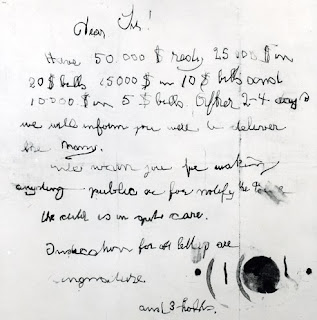Native Language Analysis for German Transference Features in the Lindbergh Kidnapping Notes
 |
| The Nursery Note |
Mark Falzini, the archivist of the New Jersey State Police Museum in possession of the notes and other evidence, is a great source for more details on the case. Mr. Falzini kindly provided me with his transcriptions of the notes, the text of which comprise an evidence corpus of 1768 words. This evidence corpus is examined using the prototype German transference catalog and the NLA methods of my thesis.
A total of 43 transference error types were identified and tagged. The table below describes the 12 most frequent transferences identified within the evidence corpus, organized according to frequency of occurrence.

These results demonstrate that roughly 50% of the transference features observed in the evidence corpus were predicted by the prototype German transfer feature catalog. Of the 12 most common errors, six are consistent with the 12 error types presented in this study’s German catalog. As described by the final column, none of the errors appear in a similar order of frequency, and some errors could fit into multiple categories. For example, errors of Punctuation-Overuse (7) and Punctuation-Choice (11) both resembled Punctuation-Overuse/Choice errors ranked 2 in the German catalog, based on the complexity of the errors; i.e., inserting unnecessary hyphens as exemplified in line 7.
As discussed in previous posts, native speakers of particular languages make predictable linguistic choices in particular target languages; predictably so that those choices can be quantified and observed as patterns. A lack of consistent patterns in linguistic choices is, characteristically, indicative of disinformation. For example, many of the Spelling-Choice errors tagged in the corpus include swapped letters, such as d for t or th. However, these spelling choices appear inconsistently and are sometimes, seemingly, forced; e.g., how the word “diet” is spelled correctly in Notes #2 and #4, but spelled “tied” in Note #9.
A German immigrant, Bruno Richard Hauptmann, was convicted and executed for the kidnapping and murder of Charles Lindbergh, Jr. Among the many theories regarding this case, it is speculated that Hauptmann did not act alone, though he maintained his innocence and never implicated any accomplices. Especially considering the potential disinformation in the writing of the kidnapping notes, I consider these results inconclusive. It is beyond the scope of my thesis to determine if the language of the kidnapping notes is in fact influenced by L1 German, or if it is perhaps the product of its author(s) attempting to disguise that L1 German influence.
Recently, on the Lindbergh Kidnapping Discussion Board, a member linked to your forensic linguist analysis of the ransom notes in the case. Having been a regular "activist" on that board for quit a number of years, I posted that the profile of the ransom note writer(s) you suggested was consistent with one Jacob Nosovitsky.
ReplyDeleteNot enough time or space here to do justice to Nosovitsky's strange personal history, but I can refer you to a book by Noel Behn, titled "Lindbergh: The Crime," which covers Nosovitsky rather extensively, and concludes that Nosovitsky is indeed the author of all but the first ransom note in the case.
I respectfully suggest that you read the Behn book with emphasis on the Nosovitsky material, then return to the ransom notes and try to make a coclusion as to whether or not you think Nosovitsky did indeed write the notes.
You can contact me at hurtelable@gmail.com
I will definitely consider doing so. If there are sufficient writing samples from this Nosovitsky, a second, authorship analysis would certainly be possible.
Deletescenarios theories:1).Parents:Chas/Anne didn't want Charlie mayof had medical problems?strange 1936b4Hauptman end went into exile .Anne became pilot flew husband Chas plane she breathe toxic fumes ate a sandwich drink water? .2.)Purple gang/Mafia-Mob 3.)wally Stroh said Jacob Nosovitsky?4.)Paul Wendel sign confession witness by Ellis Parker?5.)Gaston Means confession?6.)Dennis Doyle knew both Jacob Nosovitsky & wally Stroh and Doyle who lived Mayflower near St raymond cemetery?7.)John Knoll lived 706 Westchester ave ?8.)Isador Fisch (friend Uhlig)lived 532 E 157 and 149 E 127 near Knoll?9.)John (jafsie)Condon lived 2974 near Woodlawn cem?10.)Richard Hauptman 30 min away who had car green dodge at 1279 E 222nd Bronx? Body in Woods (charlieLindbergh) Mtn Rose hopewell-princeton Rd -Neighbors1.Robert Buffet 2.Charles Schippell (family wife charlotte daughter Charlotte b1921)3.Oscar Fengler 4.Mrs Quinn 5.Leo Rodweiller (Rodwellers) 6.George Schneck (maybe) 7.Joe Cerardi,Gerardi aka Frank Gerome -Cerardi -and Maran and Joe _ rent Schippell (Shack) place july-Oct1930s? People found Body Mtn Rose Names.Wm Allen,Livingston Titus,Orville Wileon,John Craft?Other Theories:1.Alex Carrel (experiental Operations)?2.Skillman Institue for Epilects SkillmanNJ3.ST Michaels Orphanage/industrial School(may of own land body found Mtn Rose)?In the End Ransom Notes Money found Bruno Richard Hauptmann carpenter-stock broker&spend ranson notes-hidden them but dy breath he claim's innocent-never admit any part in it?Gov Hoffman claim 2-or more involved?
ReplyDelete